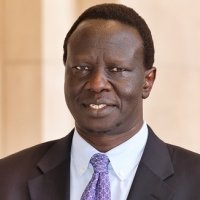Dadaab to Dollo Ado: Why East Africa's Refugee Crises Can No Longer Be Ignored
Citing security concerns, the government of Kenya recently announced their intent to close the world’s largest refugee complex, Dadaab, after almost 25 years.
The plan has attracted international criticism, and if carried out, could set a dangerous precedent, warn some. But others say Kenya has done more than enough to accommodate refugees from Somalia, Sudan, South Sudan, and other conflict-affected neighbors over more than two decades – with inadequate support from the international community.
“As the refugees increase, we’re also often confronted with reduced funding, reduced attention, and this is something that we have been grappling with for many years,” said Clementine Awu Nkweta-Salami, representative in Ethiopia for the United Nations High Commissioner for Refugees (UNHCR), at the Wilson Center on May 17. “Many of us, I would say, were not surprised by the government’s decision to take a stand.”
A panel of experts discussed the displacement crisis in East Africa, calling for a reframing of the narrative around refugees and revising the outdated humanitarian system that is failing them now.
Closing Down a City
The decision to close Dadaab will bring many logistical challenges, if carried out, said Mark Yarnell, a senior advocate at Refugees International, a humanitarian non-profit. As of this year, more than 300,000 refugees, primarily from Somalia, reside in five camps. Where to put those people and how to ensure their safety are just a few concerns.
There will also be economic implications for Kenya. Refugee camps are normally located in rural, underdeveloped areas, and Dadaab is no exception. The presence of NGOs brings educational materials, food, and jobs. Research indicates that after a few years, refugees become economic assets that contribute to a more dynamic economy, said Yarnell.
Repatriation is not an option until safety can be reasonably guaranteed
It’s estimated Dadaab conducts $25 million worth of internal business annually, he said, and Kenyan host communities make $1.8 million selling goods to refugees. Some 10,000 Kenyans could lose their jobs associated with the complex. “You’re basically going to have to eliminate an entire city,” said Yarnell.
As well, repatriation is not possible, under international law, until the safety of returning refugees can be reasonably guaranteed, said John Thon Majok, a program associate for the Environmental Change and Security Program at the Wilson Center and a former refugee from South Sudan who lived in Kenya and Ethiopia for 13 years.
“Refugee crises can be addressed if and when the push factors are addressed,” Majok said. “Refugees do not have a choice to leave their homes – they are forced by some factors that lead them to cross the borders.”
“There’s no place like home,” he said. “But if the conditions there are not conducive…then it’s a concern if the hosting government is trying to force them to return.”
What Kenya Wants
Nonetheless, Majok said Kenya’s frustration is valid. “For over a quarter a century they have hosted vulnerable people across the region and so they have done their best.”
East Africa’s refugees are caught in the middle of geopolitical negotiations, with countries paying off other countries to keep them out, said Yarnell, and others balking at opening their borders.
“Kenyan officials have pointed to what’s happening in the EU and Turkey when they’re legitimizing what they’re doing,” he said, referring to a deal between the two to divert refugees from Greece to Turkey in exchange for the gradual resettlement of asylum seekers in Europe, the lifting of visa restrictions, and EU membership consideration. Some U.S. governors “banned” the resettlement of Syrians over fears of terrorism, while the U.S. federal government announced plans to take just 10,000 in total. Meanwhile, Kenya has more than half a million refugees living within its borders.
Kenya hosts more than half a million refugees
Kenya’s decision raises legal issues and questions about the obligations of host governments under the 1951 UN Refugee Convention, Yarnell said. It also leads to difficult decisions for non-government organizations, like the UNHCR, which face a choice between accepting the decision and working to mitigate the effects on refugees, or refusing to accept it due to a legitimate fear of setting a bad precedent and jeopardizing their relationship with the government.
“At the core of these protracted situations is the absence of solutions,” said the UNHCR’s Nkweta-Salami. She acknowledged that people want to go home or integrate into Kenyan society, and hopes summits this year will lead to a global focus on solving the refugee crisis.
The panelists agreed that the humanitarian aid system, which was created in the 1940s and 50s, needs to be updated to fit the 21st century. Better coordination between the many organizations working in the space and a budget that is proportionate to the size of this crisis is important, said Majok. Last year, more people were displaced than in any year since World War II.
Although hesitant to use the word, “burden,” Nkweta-Salami insisted that other countries must help Kenya resettle some of the large numbers of refugees it hosts.
“The refugees that are impacted by this should know that the international community is standing by them to provide protections, despite what Kenya’s saying,” said Yarnell. “But at the same time we have to be realistic about what Kenya’s trying to get out of this.”
What’s Next?
The government hopes to have Dadaab closed by November, with $10 million already allocated towards repatriation. However, a more detailed timeline has not been announced.
One alternative solution could be for Kenya to provide a path to citizenship for refugees, said Yarnell. Those in Dadaab and other camps are unable to work legally or gain citizenship despite some of them being in country for more than two decades. He said an experiment to allow some to work legally in Nairobi produced positive economic results, but amid security concerns (Kenya has faced attacks by the Somalia-based terror group Al Shabaab) the government shut it down in December 2012.
“Generalizing all the refugees as a security threat is unreasonable”
“Kenya and the region should think of integration of refugees as part of the durable solution,” said Majok. “They can productively contribute to the local economy in a formal way if they are integrated into the system, and for that matter they can help resolve the security issues there if they are part of it in a formal way.”
Redefining the narrative about refugees is a critical part of this discussion, says Majok. Media representations often depict them as victims, but it is important to recognize theirunique resilience and assets, he said. “They are also resources that can effectively help in addressing the push factors [that caused them] to run away from their homes.”
Resettlement abroad is another solution. President Obama will host a refugee summit in September and one of the key priorities will be to double resettlement globally. “Currently about one percent of the world’s refugees are resettled a year so this would go to two percent,” said Yarnell. “It wouldn’t solve the issue but would be significant.”
Majok says he hopes the Kenyan government has a change of heart. “Generalizing all the refugees as a security threat is unreasonable,” he said. “The international community should take [this situation] as a negotiating opportunity to talk with Kenya about their concerns, why they are doing this, and why now.”
Event Resources:
Written Evie Kirschke-Schwartz, edited by Schuyler Null.
Speakers

Vice President, Sustainable Markets, Pact

Hosted By

Environmental Change and Security Program
The Environmental Change and Security Program (ECSP) explores the connections between environmental change, health, and population dynamics and their links to conflict, human insecurity, and foreign policy. Read more
